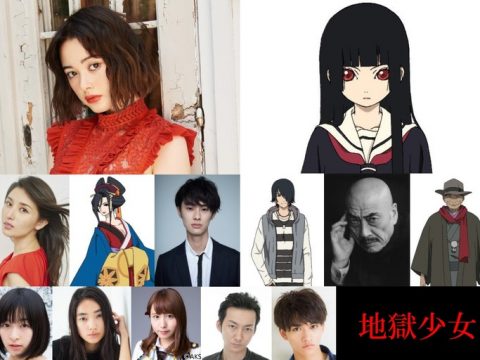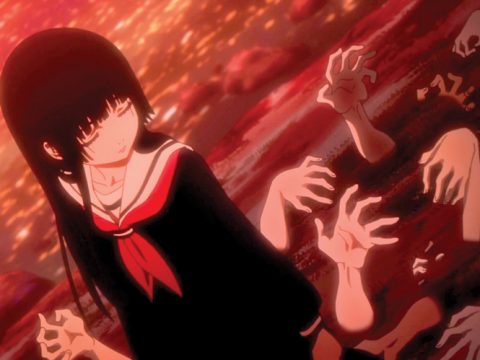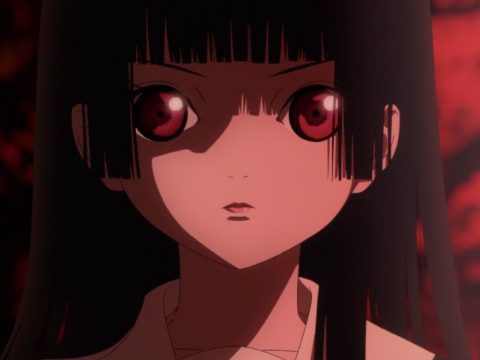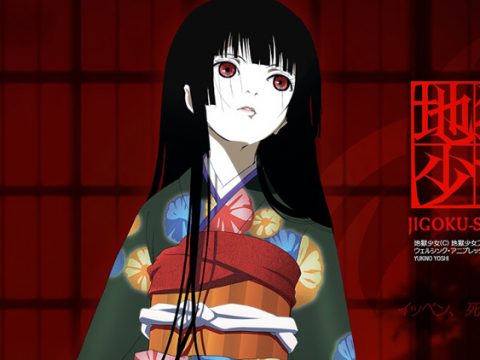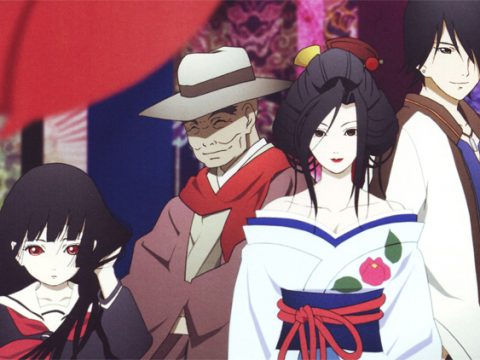Japanese horror (or J-Horror as fans of the genre like to call it) has truly captured North American audiences. With the successful re-envisioning of The Ring and The Grudge for Western fans, millions of horror aficionados are now familiar with the psychological and tension building tendencies of our Japanese counterparts. The folks at Funimation didn’t overlook the growing trends of J-Horror in North America, so they localized one of the more popular shows running in Japan, known simply as Hell Girl.
The first season of Hell Girl (and the only season currently released in the United States) is an eclectic mix of horror tales that focus on episodic protagonists that wish to exact vengeance upon the antagonist in each episode. The protagonists elicit Hell Girl’s assistance by using the “Hell Correspondence,” a website that can only be accessed at midnight. Simply type in the name of the person you wish to see pulled from their earthly coil, and Hell Girl swoops in to make sure “Your grievance has been avenged.”
Like many J-Horror films and shows, Hell Girl piles on the fright through the use of psychological tension rather than over-the-top graphical gore and imagery. Each protagonist in the show, when they use the Hell Correspondence, receives a straw doll with a red string attached to it. By pulling the string, those individuals that wished vengeance are granted their wish, but in return they “enter into a covenant” with Hell Girl and eventually will find their way into Hell as well. The psychological torment that the protagonists go through while deciding to pull the string is as much a part of the show as the horrifying ends many of the antagonists receive at the hands of Hell Girl and her lackeys.
Throughout the first season of Hell Girl, the only characters that remain constant are the Hell Girl Ai Enma, her three assistants, the reporter Hajime Shibata, and his daughter Tsugumi. While Ai Enma and her assistants always act as the bearers of vengeance in each episode, Hajime and Tsugumi offer a more human element to the entire Hell Girl story. When Hajime discovers that Tsugumi can see through the eyes of the Hell Girl when she enters the mortal realm, he uses his investigative experience to try to stop the individuals with the straw doll before they’re provoked into pulling the red string, thus killing another human being.
In Hajime’s mind, nothing that the antagonist has done warrants a death at the hands of Hell Girl, but the show often leads the viewer down paths that make us question our own moral fortitude. Whether it’s a woman that holds a young girl hostage by killing her dogs or a deranged aunt that keeps the desiccated corpse of her sister to converse with, many of Hell Girl’s victims truly deserve their punishment. But others that feel the wrath of Hell Girl are simply unfortunate bystanders or are singled out because of their positions of authority.
And it’s the moments of a viewer’s moral clarity or uncertainty that make Hell Girl shine. In storytelling, it’s the connection with the audience that the narrator is striving for, and Hell Girl’s writers often tried to attempt the same sort of resonance with their viewers. The episodes that really stood out to me were “The Woman in the Tall Tower,” “Friends,” and “The Light of the Hospital Ward,” all of which stood proud because of their moral twists and turns, ranging from pure anger to gut-wrenching pity.
Unfortunately, these moments are relatively scant in Hell Girl. The general flavor of the entire show runs mostly in the range of mediocre, with episodes that feature ends that are purely silly to conflicts that make you shrug your shoulders, wondering why the individuals fought in the first place. The low point in the season was probably “Sweet Trap,” which features the demise of a despicable chef at the hands of sweet confections.
Despite its plot flaws, the entire production quality of Hell Girl is quite high. With Funimation’s resources, they were able to cast different voices for most of the series’ protagonists and antagonists, which allowed viewers to easily discern new characters from previous appearances. The main roles were exceptional, especially Hajime (voiced by John Burgmeier), Ren (voiced by Todd Habercorn), and the enigmatic Ai (voiced by Brina Palencia). I especially enjoyed Brina’s work with Ai later in the series, when some of the stoic Hell Girl’s pent-up emotions finally come spilling out.
On top of the voice work, the art and animation quality, for the most part, is top notch. There were only a few episodes (like Sweet Trap) where I felt like the animators were cutting corners, and generally the technical ambience was quite fulfilling. Music and sounds effects were right in line with what you might expect from a horror-based television series, with dramatic silence filling the space when appropriate.
While I enjoyed the final few episodes of the first season of Hell Girl, it took me nearly fourteen episodes to really get into the series, and for most people that aren’t anime reviewers, that’s much too long. The introductory elements of the series take too much time to build up – the major recurring human characters aren’t introduced until well into the first two discs – and its this long lead in that could turn off many viewers.
If you’re a fan of J-Horror and you’re looking for a new series to fill your DVD collection, you certainly have a nice option with Hell Girl. However, those of you that aren’t as affectionate towards the suspense-filled Japanese genre may not find something unequivocally grand in Hell Girl. There are certainly some redeeming aspects in the series, and you may enjoy its totality, but for most of us the series will be hit or miss.
Studio/Company: FUNimation
Available: Now
Rating: Mature
Images © Jigoku Shoujo Project/SKY Perfect Well Think • Aniplex


